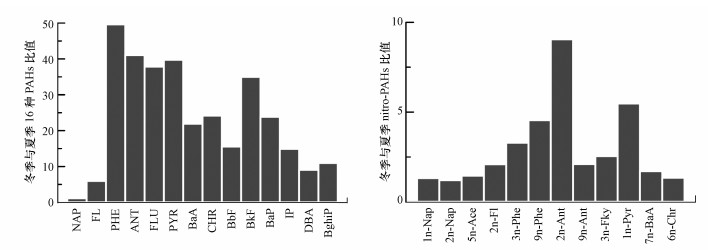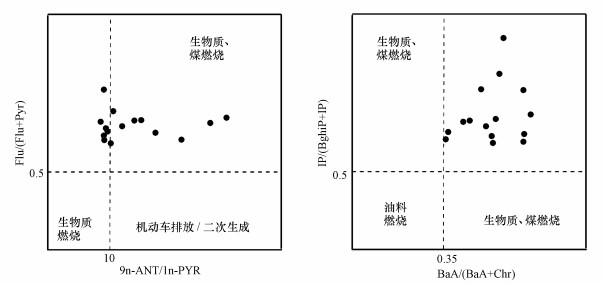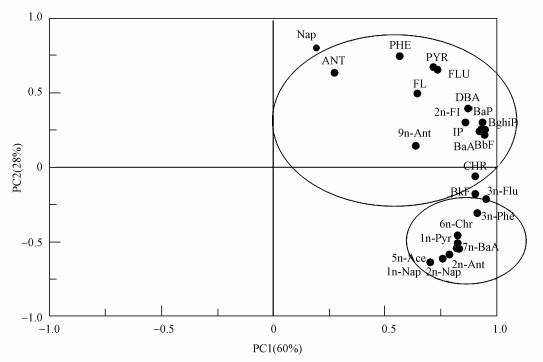2. 中国科学院广州地球化学研究所, 有机地球化学国家重点实验室, 广州 510640;
3. 中国科学院地球化学研究所, 环境地球化学国家重点实验室, 贵阳 550081
2. State Key Laboratory of Organic Geochemistry, Guangzhou Institute of Geochemistry, Chinese Academy of Sciences, Guangzhou 510640;
3. State Key Laboratory of Environmental Geochemistry, Institute of Geochemistry, Chinese Academy of Sciences, Guiyang 550081
多环芳烃(PAHs)是一类环境中广泛存在的持久性有机毒害污染物, 其污染来源和环境归趋已成为当前环境科学领域的研究热点(Keyte et al., 2013; Kim et al., 2013).近年来, 随着城市化进程的日益加快, 交通运输和各种工矿企业获得飞速发展, 使得城市大气环境问题(如PM2.5)呈现出日益严峻的趋势(Wang et al., 2012).研究表明, 我国城市大气重污染地区空气中往往含有高浓度PAHs, 通过比值法、因子分析法和多元回归模型对大气颗粒物中PAHs来源进行解析, 可在一定程度上有助于了解城市大气污染状况(He et al., 2014; Li et al., 2016a; 2016b; Meng et al., 2015; Wang et al., 2015).
PAHs具有致癌、致畸、致突变的“三致”毒性, 是目前已知环境中最大量的具有致癌性的单一化学物种.在已知的1000多种致癌物质中, PAHs的数量占1/3(PAHs及其衍生物具有致癌性的已超过400种)(高少鹏等, 2006).其中, 多环芳烃(PAHs)中苯并[α]芘是一种较强的致癌物.煤、石油、天然气等化石燃料的燃烧, 即工业废气和汽车尾气排放是目前我国城市大气中PAHs的主要来源.硝基多环芳烃(nitro-PAH)是一类带有一个或多个硝基的多环芳烃化合物, 是近20年大气环境中新发现的具有直接致突变活性的有机毒害污染物.nitro-PAHs广泛存在于大气颗粒物, 尤其是交通源颗粒物表面含有大量nitro-PAHs, 虽然其浓度较PAHs低1~2个数量级, 但其致突变和致癌潜力可达PAHs的10~1000倍, 如1, 8-二硝基芘(Durant et al., 1996; WHO, 2003).目前研究发现, 大气环境中的nitro-PAHs类化合物主要来自于2条途径:一是不完全燃烧产生的一次排放, 二是由大气发生二次化学反应产生的二次转化.二次转化有2种途径:气态PAHs被环境中的OH或NO3自由基氧化;颗粒态PAHs经与N2O5或HNO3发生非均相反应(Nielsen, 1984).
太原作为全国能源重化工基地和资源型老工业城市, 大气颗粒物污染严重, 采暖季霾天气频繁出现.本文以太原城区大气细颗粒物(PM2.5)为研究对象, 分析城区四季PM2.5中16种美国环保署优控PAHs和近年来受关注的nitro-PAHs的污染水平, 利用比值判断法和因子分析对大气中的PAHs来源进行解析, 运用健康风险评价模型进行PAHs的健康风险评估, 以期为认识和治理太原城区大气环境污染提供依据.
2 样品采集和分析(Materials and methods) 2.1 室外样品采集利用PM2.5大流量大气采样器采集太原城区2013年10月—2014年7月PM2.5样品.采样地点为中国辐射防护研究院内一栋9层高大楼(112.57°E, 37.80°N), 距地面高度约25 m, 地处城区核心区, 距离学府街主干道直线距离约50 m, 周边为商业区和居民区, 四面空旷无高层建筑物遮挡.采样时间段分为秋、冬、春、夏4个季节, 每季度采集4个样品, 每次采样时间为24 h, 共采集样品16个.
采样前, 将微孔石英纤维滤膜用铝箔纸包好, 在马弗炉中以450 ℃焙烧5 h, 放入恒温恒湿箱中平衡24 h后称重待用.用处理过的脱脂棉蘸取酒精擦洗所有与滤膜有接触的金属框架, 少量多次擦洗干净.采样的同时记录温度、湿度、风速和风向等各种气象数据, 采样完毕后将滤膜对折放回铝箔纸中密封保存, 样品放在-20 ℃冰箱里保存.
2.2 实验室PAHs浓度分析将滤膜装入150 mL鸡心瓶中, 分别加入5种氘代PAHs回收率指示物(NAP-d8、ACE-d10、PHE-d10、CHR-d12、perylene-d12)和2种氘代nitro-PAHs回收率指示物(9n-ANT-d9和6n-CHR-d11), 加入二氯甲烷超声抽提3次.提取液混合后经旋转蒸发浓缩至5 mL, 用正己烷进行溶剂转换, 浓缩至1 mL.过硅胶/氧化铝层析柱分离净化, 冲洗液是二氯甲烷和正己烷(1:1, 体积比).PAHs馏分用氮吹浓缩定容至0.2 mL, 加入六甲基苯作为内标定量物质, 进行仪器分析.
目标化合物使用气相质谱GC-ECNI-MS(Agilent GC7890与5975C MSD联用), PAHs和nitro-PAHs分别采用EI源(Electron Impact)和ECNI源(Electron Capture Negative Ion)进行检测.石英毛细管色谱柱:HP-5MS, 30 m×0.25 mm×0.25 μm.气相色谱条件:进样口温度为290 ℃, 连接口温度为300 ℃, 进样体积为1 μL, 载气为高纯氦气.色谱柱温度程序为:对于PAHs, 50 ℃保持1 min, 10 ℃·min-1升温至150 ℃, 3 ℃·min-1升温至280 ℃, 保持20 min;对于nitro-PAHs, 以15 ℃·min-1从60 ℃升温到150 ℃, 再以5 ℃·min-1升温至300 ℃, 保持15 min.PAHs的定性主要依据其特征离子和色谱保留时间, 同时与标准物质的质谱图进行对照.定量采用内标法和五点校正曲线进行, 所有化合物浓度未进行回收率校正.测定的目标化合物见表 1.本实验样品分析中增加1个方法空白和1个样品平行样, 5种氘代PAHs和2种氘代nitro-PAHs回收率结果均高于80%, 上述所有质量控制结果均满足实验要求.
| 表 1 本研究测定的目标化合物、致癌等效系数及研究期间太原城区PM2.5中PAHs浓度 Table 1 Information list of target PAH compounds and concentrations of PAHs in PM2.5 from the atmosphere of Taiyuan |
健康风险评价模型主要基于PAHs浓度及其相应的以BaP为参照的致癌等效因子(TEF)(Nisbet et al., 1992), 来计算以BaP为参照的致癌等效浓度(TEQ), 评估PAHs通过PM2.5暴露途径对人群的终身致癌风险.PAHs致癌风险根据公式(1)进行计算.

|
(1) |
式中, TEQ为测定的PAHs总致癌等效浓度(ng·m-3), C和TEF分别为单个PAH的浓度和致癌等效系数(表 1).
3 结果与讨论(Results and discussion) 3.1 太原城区PM2.5中PAHs浓度水平和季节特征采样期间, 太原城区PM2.5样品中PAHs浓度为13.8~547 ng·m-3, 夏季浓度最低(13.8~27.0 ng·m-3), 冬季浓度最高(476~547 ng·m-3), 春季和秋季浓度水平介于两者之间, 分别为53.4~177 ng·m-3和62.5~347 ng·m-3.太原城区PM2.5中PAHs的浓度水平和季节特征与近年来我国北方工业城市大气多环芳烃的调查研究基本一致(段凤魁等, 2009;周变红等, 2012).通过冬季与夏季PAHs浓度的比较(图 1), 发现不同化合物的增加幅度差异显著, 其中, 菲的增加幅度最高, 超过40倍, 蒽、荧蒽、芘和苯并[k]荧蒽的增加幅度在30~40倍之间.一般认为, 我国大气环境中3环和4环PAHs主要来自煤燃烧排放, 尤其是低温煤燃烧过程(Xu et al., 2006).因此, 冬季PAHs的大幅度增加与北方城市冬季供暖导致燃煤使用量增加有直接的关系, 同时, 采暖期不利于污染物扩散的稳定气象条件更加重了近地表污染.
 |
| 图 1 冬季、夏季太原城区PM2.5中多环芳烃和硝基多环芳烃浓度对比 Fig. 1 Variations between winter and summer in the concentrations of individual PAHs (indicated by max-to-min ratio) in PM2.5 from the atmosphere of Taiyuan |
本研究测定的12种nitro-PAHs浓度为0.70~4.33 ng·m-3, 其中, 浓度最高的化合物是9-硝基蒽, 其余依次为2-硝基萘和1-硝基萘.太原城区大气中nitro-PAHs主要以低环数(2~3环)为主, 不同于发达国家城市大气中nitro-PAHs以高环数(4环)为主, 如日本东京(Kojima et al., 2010)、丹麦哥本哈根(Feilberg et al., 2001)、西班牙马德里(Barrado et al., 2013).来自巴西甘蔗主产区和我国北方农村的研究结果显示, 木材低温燃烧会产生低环数nitro-PAHs(de Castro Vasconcellos et al., 2008; Li et al., 2015).因此, 推断太原城区冬季低环数nitro-PAHs(尤其是9-硝基蒽)有来自周边地区木材燃烧的贡献.季节上, 最高值出现在冬季, 最低值出现在夏季;但不同于PAHs, nitro-PAHs(除9-硝基蒽)冬季浓度均值与夏季的差异小于5倍.基于多数研究已证实高环数nitro-PAHs生成反应与机动车尾气排放有关, 太原城区nitro-PAHs季节特征不同于PAHs, 反映出机动车尾气排放量不受季节控制, 这与实际情况相吻合.
3.2 太原城区大气中PAHs的来源解析PAHs按照环数可以分为2~6环.一般认为, 低分子量(2~3环)的PAHs主要来源于石油类污染;4环及其以上的PAHs主要由高温不完全燃烧生成(Yunker et al., 2002).本研究中, PM2.5主要以4~6环化合物为主, 占总PAHs的85%~96%.4环及其以上的PAHs主要由高温不完全燃烧生成, 利用同分子量单组分间相对浓度的比值(如荧蒽/(荧蒽+芘)、苯并[a]蒽/(苯并[a]蒽+)、茚并[1, 2, 3-cd]芘/(茚并[1, 2, 3-cd]芘+苯并[g, h, i]苝))可以进一步判别其来源(Yunker et al., 2002).通过比值研究发现, 荧蒽/(荧蒽+芘)在0.4~0.5之间为油类燃烧来源, 比值大于0.5为木材、煤燃烧来源;苯并[a]蒽/(苯并[a]蒽+)>0.35为木材、煤燃烧来源;茚并[1, 2, 3-cd]芘/(茚并[1, 2, 3-cd]芘+苯并[g, h, i]苝)在0.2~0.5之间为油类燃烧来源, 比值大于0.5为木材、煤燃烧来源.通过这些比值对照太原城区PM2.5中PAHs结果表明(图 2), 太原城区大气颗粒物中PAHs主要是来自煤和木材的燃烧, 与目前该城市的能源结构相吻合.
 |
| 图 2 太原城区大气PM2.5中化合物浓度比值及其指示来源 Fig. 2 PAH ratios for source identification in PM2.5 from the atmosphere of Taiyuan |
Chuesaard等(2014)利用9-硝基蒽/1-硝基芘的比值来指示9-硝基蒽化合物的来源.9-硝基蒽/1-硝基芘比值大于10表示木材燃烧来源, 小于10表示机动车尾气排放来源.本研究中, 9-硝基蒽/1-硝基芘比值在夏季小于10, 其他季节均显著高于10, 结果显示, 夏季9-硝基蒽主要来自机动车尾气排放, 其他季节有来自周边地区木材燃烧贡献(图 2).这在一定程度上也解释了9-硝基蒽不同于其他nitro-PAHs, 表现出类似PAHs的显著季节变化(冬季浓度均值高于夏季,差异>10倍).
除了浓度季节变化和化合物比值特征之外, 利用主因子分析同样是解析区域PAHs来源的重要手段.图 3是太原城区PM2.5中14种PAHs(苊和二氢苊由于检出率低于30%, 因此, 不纳入本因子分析以免影响分析结果)和12种nitro-PAHs的因子载荷图.2个主因子分别可以解释总方差的60%和28%, 累计方差为88%.因子1中载荷较高的是4~6环PAHs, 这些化合物主要是石化产品高温燃烧的排放产物.萘、蒽和菲在第2因子上具有较高的载荷, 这些化合物是原油和轻质油类产品的重要组成部分和主要降解产物, 可以作为石油源的指示物.因此, 太原城区大气PM2.5中PAHs主要来自燃烧源和石油源的贡献.另一方面, 通过化合物在因子荷载图上的分布可以看出, nitro-PAHs(除9-硝基蒽和2-硝基芴外)和PAHs被明显区分开, 说明两者之间并不存在显著的相关性, PAHs主要来自一次排放的贡献, nitro-PAHs可能以二次转化为主.因子荷载图中9-硝基蒽落在PAHs分区中, 这一点说明9-硝基蒽主要来自一次排放(木材燃烧)的贡献, 这与上述9-硝基蒽/1-硝基芘的比值分析结果是一致的.
 |
| 图 3 太原城区大气PM2.5中多环芳烃的主因子分析图 Fig. 3 PCA plot for the first two components of all PAHs in PM2.5 from the atmosphere of Taiyuan |
本研究以苯并[a]芘(BaP)为毒性参照物的致癌性当量浓度(TEF)作为PM2.5暴露途径的基本暴露致癌浓度(TEQ).在之前的多数研究中, 往往只是基于16种优控PAHs的浓度结果, 本研究在此基础上, 进一步加入nitro-PAHs, 使得健康风险评价结果更客观.估算结果显示, 太原城区PM2.5致癌等效平均浓度为(23 ± 23) ng·m-3, 与Li等(2014)在太原的研究结果相吻合(28 ng·m-3), 但高于西安(Bandows et al., 2014)、广州(Huang et al., 2014)、北京(Lin et al., 2015)等地的研究结果.需要特别指出的是, 太原城区冬季TEQ高达32 ng·m-3, 表明长时间暴露在冬季大气环境中, 通过呼吸途径所造成的成人和儿童的终身致癌超额危险度可能高于可接受水平, 其健康风险不容忽视.
4 结论(Conclusions)1) 太原城区PM2.5中PAHs组成主要以4~6环化合物为主, 占总PAHs的85%~96%;同分子量单组分PAHs比值结果显示主要是来自煤和木材的燃烧.PAHs浓度具有明显的季节差异:夏季<春季<秋季<冬季;冬季浓度均值相对夏季增加幅度超过20倍, 这与北方城市冬季供暖导致燃煤使用量增加有直接的关系.
2) 太原城区PM2.5中nitro-PAHs浓度低于PAHs浓度1~2个数量级, 主因子分析结果显示, 两组化合物之间并不存在显著的相关性;不同于PAHs, nitro-PAHs冬季浓度均值与夏季的差异小于5倍(除9-硝基蒽), 表明nitro-PAHs主要来自机动车尾气排放的二次生成, 而机动车尾气排放量季节差异较小, 这与实际情况相吻合.
3) 太原城区PM2.5中9-硝基蒽浓度显著高于其他nitro-PAHs, 且冬季与夏季浓度比值(>10)高于其他nitro-PAHs;此外, 9-硝基蒽/1-硝基芘比值和主因子分析结果都表明太原城区PM2.5中9-硝基蒽有来自周边地区木材燃烧的贡献.
4) 基于PAHs浓度计算得到太原城区PM2.5致癌等效平均浓度(TEQ)为(23±23) ng·m-3, 太原冬季TEQ高达32 ng·m-3, 表明长时间暴露在冬季大气环境中, 通过呼吸途径所造成的成人和儿童的终身致癌超额危险度可能高于可接受水平, 其健康风险不容忽视.
Bandowe B A M, Meusel H, Huang R J, et al. 2014. PM2.5-bound oxygenated PAHs, nitro-PAHs and parent-PAHs from the atmosphere of a Chinese megacity:Seasonal variation, sources and cancer risk assessment[J]. Science of Total Environment, 473-474: 77–87.
DOI:10.1016/j.scitotenv.2013.11.108
|
Barrado A I, García S, Castrillejo Y, et al. 2013. Exploratory data analysis of PAH, nitro-PAH and hydroxy-PAH concentrations in atmospheric PM10-bound aerosol particles. Correlations with physical and chemical factors[J]. Atmospheric Environment, 67: 385–393.
DOI:10.1016/j.atmosenv.2012.10.030
|
Bostr m C E, Gerde P, Hanberg A, et al. 2002. Cancer risk assessment, indicators, and guidelines for polycyclic aromatic hydrocarbons in the ambient air[J]. Environmental Health Perspectives, 110(Suppl 3): 451–489.
|
Chuesaard T, Chetiyanukornkul T, Kameda T, et al. 2014. Influence of biomass burning on the levels of atmospheric polycyclic aromatic hydrocarbons and their nitro derivatives in Chiang Mai, Thailand[J]. Aerosol and Air Quality Research, 14: 1247–1257.
|
de Castro Vasconcellos P, Sanchez-Ccoyllo O, Balducci C, et al. 2008. Occurrence and concentration levels of nitro-pah in the air of three brazilian cities experiencing different emission impacts[J]. Water, Air, and Soil Pollution, 190: 87–94.
DOI:10.1007/s11270-007-9582-y
|
Durant J L, Busby W F, Lafleur A L, et al. 1996. Human cell mutagenicity of oxygenated, nitrated and unsubstituted polycyclic aromatic hydrocarbons associated with urban aerosols[J]. Mutation Research:Genetic Toxicology and Environmental Mutagenesis, 371: 123–157.
DOI:10.1016/S0165-1218(96)90103-2
|
段凤魁, 贺克斌, 马永亮. 2009. 北京PM2.5中多环芳烃的污染特征及来源研究[J]. 环境科学学报, 2009, 29(7): 1363–1371.
|
Feilberg A B, Poulsen M W, Nielsen T, et al. 2001. Occurrence and sources of particulate nitro-polycyclic aromatic hydrocarbons in ambient air in Denmark[J]. Atmospheric Environment, 35: 353–366.
DOI:10.1016/S1352-2310(00)00142-4
|
高少鹏, 刘大锰, 安祥华, 等. 2006. 高效液相色谱法测定某钢铁厂地区大气颗粒物PM2.5中16种多环芳烃[J]. 环境科学, 2006, 27(6): 1052–1055.
|
He J, Fan S, Meng Q, et al. 2014. Polycyclic aromatic hydrocarbons (PAHs) associated with fine particulate matters in Nanjing, China:distributions, sources and meteorological influences[J]. Atmospheric Environment, 89: 207–215.
DOI:10.1016/j.atmosenv.2014.02.042
|
Huang B, Liu M, Bi X, et al. 2014. Phase distribution, sources and risk assessment of PAHs, NPAHs and OPAHs in a rural site of Pearl River Delta region, China[J]. Atmospheric Pollution Research, 5(2): 210–218.
DOI:10.5094/APR.2014.026
|
Keyte I J, Harrison R M, Lammel G. 2013. Chemical reactivity and long-range transport potential of polycyclic aromatic hydrocarbons-a review[J]. Chemical Society Reviews, 42: 9333–9391.
DOI:10.1039/c3cs60147a
|
Kim K H, Jahan S A, Kabir E, et al. 2013. A review of airborne polycyclic aromatic hydrocarbons (PAHs) and their human health effects[J]. Environment International, 60: 71–80.
DOI:10.1016/j.envint.2013.07.019
|
Kojima Y, Inazu K, Hisamatsu Y, et al. 2010. Influence of secondary formation on atmospheric occurrences of oxygenated polycyclic aromatic hydrocarbons in airborne particles[J]. Atmospheric Environment, 44(24): 2873–2880.
DOI:10.1016/j.atmosenv.2010.04.048
|
Li H, Guo L, Cao R, et al. 2016a. A wintertime study of PM2.5-bound polycyclic aromatic hydrocarbons in Taiyuan during 2009-2013:Assessment of pollution control strategy in a typical basin region[J]. Atmospheric Environment, 140: 404–414.
DOI:10.1016/j.atmosenv.2016.06.013
|
Li R J, Kou X J, Geng H, et al. 2014. Pollution characteristics of ambient PM2.5-bound PAHs and NPAHs in a typical winter time period in Taiyuan[J]. Chinese Chemical Letters, 25(5): 663–666.
DOI:10.1016/j.cclet.2014.03.032
|
Li W, Wang C, Shen H, et al. 2015. Concentrations and origins of nitro-polycyclic aromatic hydrocarbons and oxy-polycyclic aromatic hydrocarbons in ambient air in urban and rural areas in northern China[J]. Environmental Pollution, 197: 156–164.
DOI:10.1016/j.envpol.2014.12.019
|
Li X, Kong S, Yin Y, et al. 2016b. Polycyclic aromatic hydrocarbons (PAHs) in atmospheric PM2.5 around 2013 Asian Youth Games period in Nanjing[J]. Atmospheric Research, 174-175: 85–96.
DOI:10.1016/j.atmosres.2016.01.010
|
Lin Y, Ma Y, Qiu X, et al. 2015. Sources, transformation, and health implications of PAHs and their nitrated, hydroxylated, and oxygenated derivatives in PM2.5 in Beijing[J]. Journal of Geophysical Research:Atmospheres, 120(14): 7219–7228.
DOI:10.1002/2015JD023628
|
Meng Q, Fan S, He J, et al. 2015. Particle size distribution and characteristics of polycyclic aromatic hydrocarbons during a heavy haze episode in Nanjing, China[J]. Particuology, 18: 127–134.
DOI:10.1016/j.partic.2014.03.010
|
Nielsen T. 1984. Reactivity of polycyclic aromatic hydrocarbons towards nitrating species[J]. Environmental Science & Technology, 18: 157–163.
|
Nisbet I C T, LaGoy P K. 1992. Toxic equivalency factors (TEFs) for polycyclic aromatic hydrocarbons (PAHs)[J]. Regulatory Toxicology and Pharmacology, 16: 290–300.
DOI:10.1016/0273-2300(92)90009-X
|
USEPA. 2010. Development of a Relative Potency Factor (RPF) Approach for Polycyclic Aromatic Hydrocarbon (PAH) Mixtures (External Review Draft)[R]. EPA/635/R-08/012A. Washington, DC: USEPA
|
Wang F, Lin T, Feng J, et al. 2015. Source apportionment of polycyclic aromatic hydrocarbons in PM2.5 using positive matrix factorization modeling in Shanghai, China[J]. Environmental Science:Processes & Impacts, 17: 197–205.
|
Wang S, Hao J. 2012. Air quality management in China:Issues, challenges, and options[J]. Journal of Environmental Sciences, 24: 2–13.
DOI:10.1016/S1001-0742(11)60724-9
|
WHO. 2003. Environmental Health Criteria 229: Selected nitro-and nitrooxy-polycyclic aromatic hydrocarbons[S]. Geneva: World Health Organization
|
Xu S, Liu W, Tao S. 2006. Emission of polycyclic aromatic hydrocarbons in China[J]. Environmental Science & Technology, 40(3): 702–708.
|
Yunker M B, Macdonald R W, Vingarzan R, et al. 2002. PAHs in the Fraser River basin:a critical appraisal of PAH ratios as indicators of PAH source and composition[J]. Organic Geochemistry, 33(4): 489–515.
DOI:10.1016/S0146-6380(02)00002-5
|
周变红, 张承中, 王格慧. 2012. 西安城区大气中多环芳烃的季节变化特征及健康风险评价[J]. 环境科学学报, 2012, 32(9): 2324–2331.
|
 2018, Vol. 38
2018, Vol. 38


